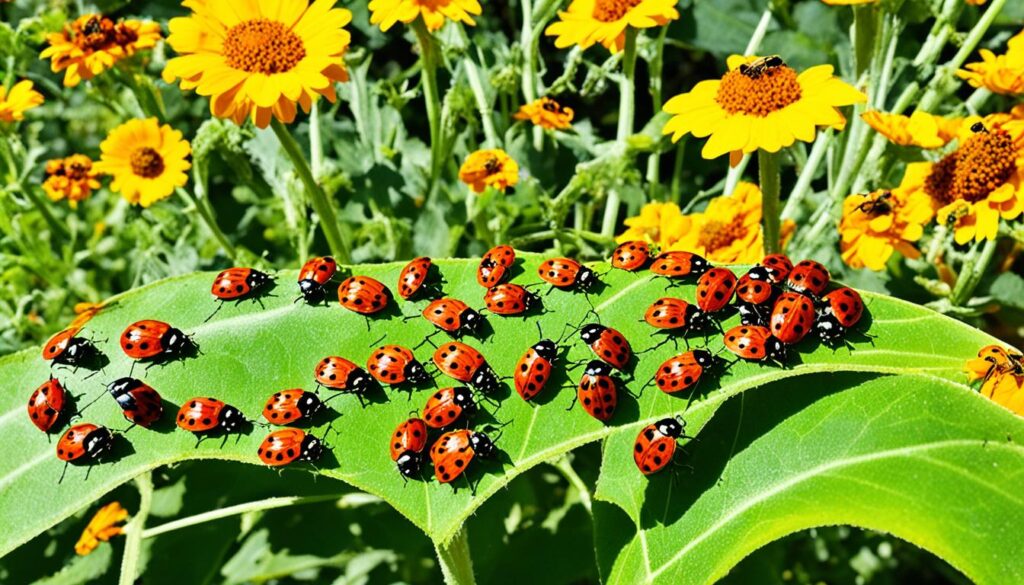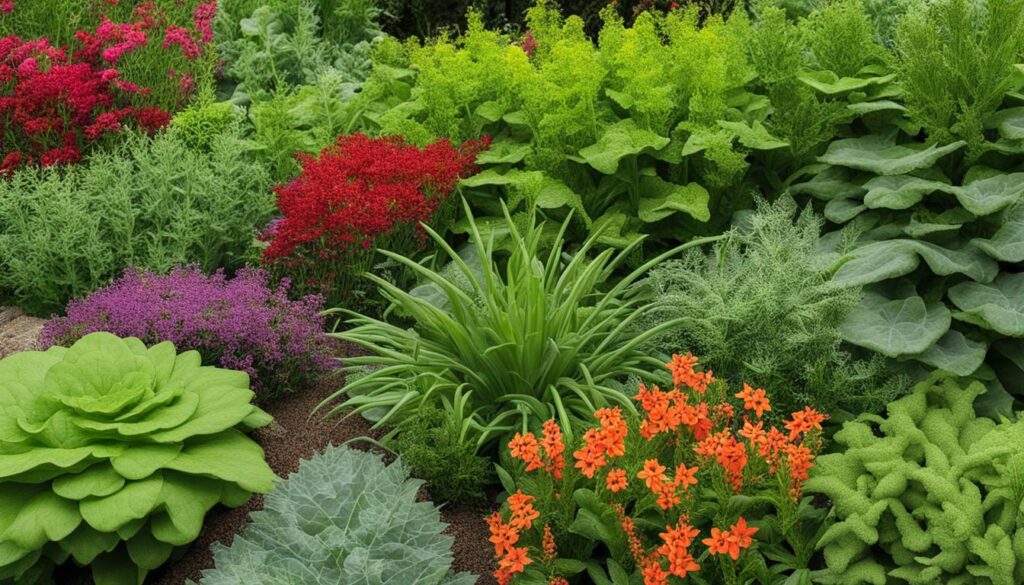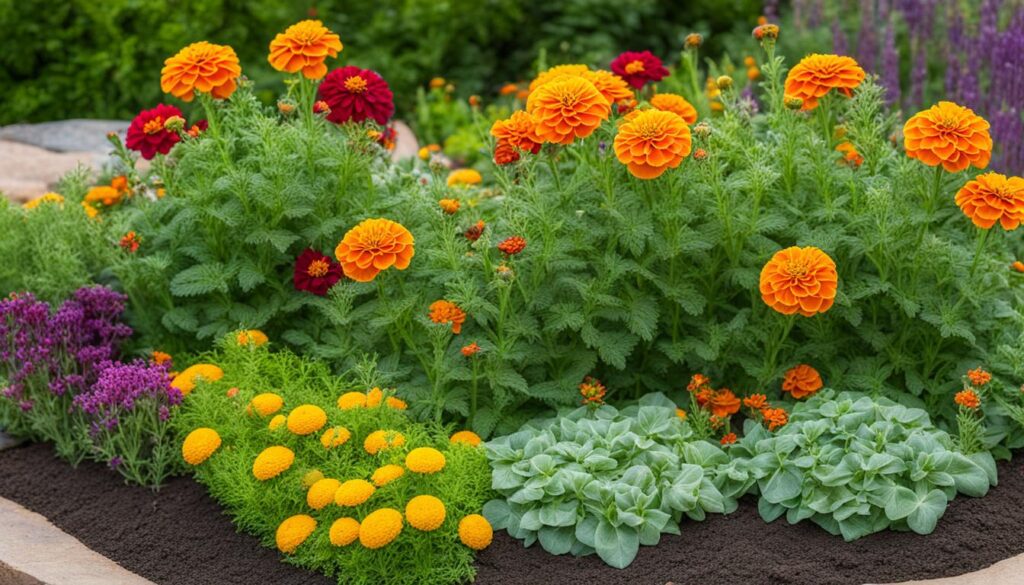Gardening is a rewarding hobby that allows me to connect with nature and enjoy the fruits of my labor. As an organic gardener, I prioritize the health of my plants and the environment. That’s why I’m always on the lookout for natural solutions to control pests and promote a thriving garden. One strategy that has proven to be effective is companion planting for pest control.
Companion planting involves strategically planting certain combinations of plants to create a balanced environment that deters invasive pests and reduces the need for chemical pest control. By harnessing the power of nature, we can rely on beneficial insects and pest-repellent plants to manage pests and maintain a healthy garden.
Key Takeaways:
- Companion planting is a natural and effective method for pest management in the garden.
- By increasing plant diversity and attracting beneficial insects, we can reduce the need for chemical interventions.
- Pest-repellent plants and specific companion planting combinations can deter troublesome insects.
- Avoiding pesticides and adopting sustainable gardening practices contribute to a healthier garden ecosystem.
- Companion planting offers additional benefits such as enhanced biodiversity and flavor enhancement.
Principle 1: More Plant Diversity Equals Fewer Pests
The first principle of companion planting for pest control is to increase plant diversity in your garden. By including a variety of flowers, herbs, and vegetables, you create a habitat that supports beneficial insects while deterring pests. The concept is simple: when you mix different plants together, you disrupt the ability of pests to locate their favorite host plants. This confusion makes it harder for pests to find and attack your crops, resulting in fewer pest problems overall.
When you incorporate herbs and flowers into your garden, you introduce scents that can interfere with pest insects’ navigation systems. For example, the strong aroma of basil can mask the scent of vegetables like tomatoes, making it difficult for pests to find them. Similarly, the fragrance of flowers such as marigolds can confuse pests and deter them from attacking nearby plants.
By embracing plant diversity in your garden, you create a dynamic and balanced ecosystem. The presence of multiple plant species attracts a diverse range of beneficial insects, such as ladybugs, lacewings, and hoverflies. These insects feed on common garden pests like aphids and caterpillars, providing natural pest control. Additionally, plant diversity enhances biodiversity and promotes overall garden health, reducing the need for chemical pesticides and creating a more sustainable gardening approach.
“When you embrace plant diversity in your garden, you create a dynamic and balanced ecosystem that naturally repels pests and promotes plant health.”
The Benefits of Plant Diversity for Pest Control
- Confuses and deters pest insects
- Introduces scents that interfere with pest navigation
- Attracts beneficial insects for natural pest control
- Enhances biodiversity and overall garden health
- Reduces the need for chemical pesticides
- Creates a more sustainable gardening approach
Principle 2: Grow Companion Plants that Create a Habitat for Beneficial Insects
The second principle of companion planting for pest control focuses on selecting companion plants that attract and support beneficial insects in the garden. By incorporating these plants into your garden, you create a favorable habitat for insects that contribute to natural pest control, reducing the need for chemical interventions.
Beneficial Insects: Nature’s Pest Control
Beneficial insects play a crucial role in maintaining a healthy garden ecosystem. They prey on harmful pests, pollinate flowers, and help with nutrient cycling. By attracting and supporting these beneficial insects through companion planting, you can create a balance that keeps pest populations in check.
Some commonly found beneficial insects include:
- Ladybugs: These voracious eaters consume aphids, mites, and other soft-bodied pests that can damage plants.
- Lacewings: Known as the “aphid lions,” lacewings feed on aphids and other small insects.
- Hoverflies: Hoverflies, also known as flower flies, are important pollinators and also prey on aphids.
- Parasitic Wasps: These tiny wasps lay their eggs inside pest insects, effectively controlling their populations.
By growing companion plants that attract and support these beneficial insects, you create a sustainable pest management system that reduces your reliance on chemical pesticides.
Companion Plants that Attract Beneficial Insects
A wide range of companion plants can be grown to attract beneficial insects to your garden. Herbs and flowers are particularly effective in attracting these helpful creatures. Consider incorporating the following companion plants into your garden:
| Herbs | Flowers |
|---|---|
| Mint | Nasturtium |
| Tansy | Marigold |
| Catnip | Cosmos |
| Wormwood | Alyssum |
| Dill | |
| Basil | |
| Parsley | |
| Fennel | |
| Cilantro |
These companion plants not only attract beneficial insects but also have properties that repel pests. Mint, for example, repels ants and aphids, while tansy deters flies and mosquitoes. Marigolds are known to repel nematodes and whiteflies.
Creating a Welcoming Habitat
When incorporating companion plants into your garden, it’s important to consider the needs of beneficial insects. Providing a diverse range of flowering plants ensures a constant source of nectar for the insects to feed on. Additionally, providing shelter in the form of shrubs or small trees can provide nesting sites for beneficial insects.

Remember, beneficial insects are a valuable asset in your pest control efforts. By creating a habitat that attracts and supports them, you encourage natural pest management and promote the overall health of your garden.
Principle 3: Test Specific Companion Planting Combinations for Your Troublesome Insects
The third principle of companion planting for pest control involves experimenting with specific companion planting combinations to target and deter troublesome insects. While certain combinations may work well in one garden, they may not be as effective in another. It’s important to test different combinations in your garden to find what works best for your specific pest issues.
I once had a problem with cabbage worms in my garden. After some research, I discovered that planting thyme near my cabbage plants could help repel these pests. I gave it a try, and to my surprise, the cabbage worms were significantly reduced. This experience taught me the value of testing companion planting combinations to find effective solutions.
Just like vegetables, herbs can also have pest-repellent properties. For example, planting onions and nasturtiums among your squash plants can help deter squash bugs. By experimenting with different combinations of herbs, flowers, and vegetables, you can find the ideal mix to control troublesome insects in your garden.
Companion Planting Combinations for Troublesome Insects:
- Thyme: Repels cabbage worms when planted near cabbage plants.
- Onions and Nasturtiums: Help deter squash bugs when planted among squash plants.
- Chives and Carrots: Chives can repel aphids, and planting them near carrots can help deter carrot fly.
- Basil and Tomatoes: Basil can repel tomato hornworms, making it an excellent companion for tomato plants.

Remember, every garden is unique, and what works for one gardener may not work for another. It’s essential to experiment with different companion planting combinations to find what works best for you. By observing the results and adjusting your plantings accordingly, you can effectively control troublesome insects and maintain a healthy and pest-free garden.
Stop Using Pesticides
One of the key principles of companion planting for pest control is to avoid the use of pesticides. While pesticides may offer temporary relief from pests, they can also harm beneficial insects and disrupt the natural balance of your garden.
Instead of relying on chemicals, I recommend using pesticide alternatives and embracing natural solutions for pest control. By implementing organic gardening practices, you can create a more sustainable and environmentally-friendly garden.
Here are some pesticide alternatives and natural solutions for effective pest control:
- Manual methods: Consider picking or squashing pests by hand. This can be a simple yet effective way to manage small pest populations and eliminate the need for pesticides.
- Floating row covers: Use lightweight covers to physically protect your plants from insect pests. This method creates a barrier while allowing sunlight, air, and water to reach the plants.
- Creating healthy soil: Focus on building and maintaining healthy soil through composting and organic amendments. Strong, healthy plants are more resistant to pests and diseases.
By eliminating the use of pesticides and incorporating these natural solutions into your gardening routine, you can promote a healthier ecosystem and protect beneficial insects that play a vital role in pest control.
“The greatest threat to our planet is the belief that someone else will save it.” – Robert Swan

The Benefits of Companion Planting
Companion planting offers numerous benefits beyond pest control. By incorporating diverse plants in your garden, you promote biodiversity and create a healthier ecosystem. The presence of beneficial insects helps with pollination and contributes to overall plant health. Additionally, companion planting can improve soil fertility, reduce weed growth, and enhance the flavor of certain crops. By embracing companion planting practices, you can foster a more sustainable and resilient garden.
One of the key advantages of companion planting is the promotion of biodiversity. By growing a variety of plants, you create a habitat that attracts a wide range of organisms, including beneficial insects. These insects, such as ladybugs, lacewings, and hoverflies, prey upon common garden pests like aphids, mites, and caterpillars. This natural pest control method reduces the need for synthetic pesticides, making companion planting a more environmentally-friendly option for pest management in your garden.
Furthermore, companion planting enhances plant health by supporting proper pollination. Many flowering plants used in companion planting, such as marigolds and sunflowers, act as nectar sources for bees and other pollinators. These insects transfer pollen from one plant to another, ensuring the successful fertilization of flowers and the production of fruits and seeds. With proper pollination, plants can reach their full potential and produce abundant yields.
In addition to pest control and pollination, companion planting also improves soil fertility. Certain plants, known as “nitrogen fixers,” have the ability to convert atmospheric nitrogen into a form that is useable by other plants. Legumes, such as peas and beans, are excellent nitrogen fixers that can enrich the soil with this essential nutrient. By interplanting nitrogen-fixing plants with your vegetables, you create a self-sustaining system that naturally replenishes soil fertility.
Companion planting also helps reduce weed growth, thereby minimizing competition for nutrients, water, and sunlight. The dense foliage of companion plants shades the soil, making it less favorable for weed establishment. By crowding out weeds and creating a physical barrier, companion plants act as natural weed suppressors, reducing the need for manual weeding or chemical herbicides in your garden.
Lastly, companion planting can enhance the flavor of certain crops. Some combinations of companion plants are believed to release chemicals or aromas that improve the taste of neighboring crops. For example, planting basil near tomatoes is thought to enhance the flavor of the tomatoes. This natural synergy between plants adds an extra dimension of enjoyment to your harvest, transforming ordinary meals into extraordinary culinary experiences.
Companion Planting Benefits
| Benefit | Description |
|---|---|
| Biodiversity | Incorporating diverse plants promotes a healthier ecosystem and attracts beneficial insects for natural pest control. |
| Plant Health | The presence of beneficial insects supports proper pollination, leading to higher yields and healthier plants. |
| Soil Fertility | Nitrogen-fixing plants improve soil quality by converting atmospheric nitrogen into usable forms for other plants. |
| Weed Suppression | Companion plants shade the soil, reducing weed growth and minimizing competition for resources. |
| Flavor Enhancement | Some companion plant combinations can enhance the flavor of neighboring crops, elevating culinary experiences. |
By embracing the benefits of companion planting, you can create a more sustainable and resilient garden. Not only does it provide natural pest control and improve plant health, but it also contributes to biodiversity, enhances soil fertility, suppresses weeds, and enhances the flavor of your crops. Incorporating companion planting practices into your organic gardening routine will help you create a thriving and harmonious garden ecosystem.
Popular Companion Plants for Pest Control
When it comes to pest control in your garden, there are many popular companion plants that can help keep those pesky insects at bay. These companion plants have natural pest-repellent properties, making them a valuable addition to any organic garden. By incorporating these plants alongside your vegetables, herbs, and flowers, you can create a natural defense against common garden pests.
Example Companion Plant Combinations
Here are a few examples of popular companion plants for pest control:
| Companion Plant | Pests Controlled |
|---|---|
| Marigolds | Cabbage worms, aphids |
| Nasturtiums | Squash bugs |
| Basil | Mosquitoes, flies |
| Oregano | Spider mites, aphids |
| Parsley | Carrot flies |
| Thyme | Cabbage worms, slugs |
These are just a few examples, and there are many more companion plants available for different types of pests. By researching and selecting the right companion plants for your specific garden needs, you can effectively manage pests without relying on harmful chemical pesticides.

Remember, companion planting is not a one-size-fits-all solution. It’s important to experiment and find the best combinations that work for your garden. Regular observation and monitoring will help you identify any potential pest issues and make necessary adjustments.
By incorporating popular companion plants for pest control, you can create a healthier and more balanced ecosystem in your garden, reducing the need for chemical interventions and promoting organic gardening practices.
Beyond Pest Control: Additional Benefits of Companion Planting
Companion planting offers more than just pest control benefits for your garden. By embracing this practice, you can unlock a range of additional advantages that contribute to a thriving and sustainable garden environment.
Promoting Biodiversity
One of the key benefits of companion planting is the promotion of biodiversity in your garden. By incorporating a variety of companion plants, you create a diverse and interconnected ecosystem. This diversity attracts a wide range of beneficial insects, birds, and other wildlife, fostering a healthy and balanced environment.
Improving Nutrient Cycling
Companion planting enhances the natural process of nutrient cycling in the soil. Different plants have varying nutrient requirements, and by interplanting complementary crops, you can maximize the efficiency of nutrient absorption. For example, legume plants have the unique ability to fix nitrogen in the soil, which benefits neighboring plants by providing them with a readily available source of this essential nutrient.
Suppressing Weed Growth
Another advantage of companion planting is its ability to suppress weed growth. Dense planting and strategic combinations of companion plants can create a canopy effect, shading the soil and preventing weed seeds from germinating. This natural weed control method reduces the need for manual weeding and minimizes competition for resources, allowing your garden plants to thrive.
Enhancing Flavor
Certain companion plants have the remarkable ability to enhance the flavor of neighboring crops. For example, planting basil near tomatoes can intensify their taste, while growing dill alongside cucumbers can provide a flavorful boost. This flavor enhancement adds an extra layer of enjoyment to your harvest and allows you to savor the true essence of your homegrown produce.
To illustrate the benefits of companion planting, consider the following table:
| Benefit | Explanation |
|---|---|
| Promoting Biodiversity | Companion planting creates a diverse ecosystem that attracts beneficial insects and wildlife. |
| Improving Nutrient Cycling | Companion plants with different nutrient requirements improve nutrient absorption and availability in the soil. |
| Suppressing Weed Growth | The dense planting of companion plants creates shade, suppressing weed growth and reducing competition for resources. |
| Enhancing Flavor | Certain companion plants can enhance the flavor of neighboring crops, elevating the taste of your harvest. |
By considering these additional benefits, you can maximize the potential of companion planting in your garden, creating a vibrant and flourishing space that nurtures both plants and wildlife.
Companion Planting Tips and Best Practices
To successfully implement companion planting for pest control in your organic garden, there are a few tips and best practices to keep in mind:
1. Research and Select Compatible Companion Plants
Before starting your companion planting journey, take the time to research and select companion plants that are compatible with each other. Some plants have natural synergies, while others may compete for resources or attract similar pests. Consider the growth habits, nutrient requirements, and pest-repellent properties of each plant to create a harmonious combination.
2. Pay Attention to Proper Spacing and Timing
Proper spacing is vital for companion plants to thrive and interact effectively with each other. Allow enough room for each plant to spread its roots and access ample sunlight and nutrients. Additionally, consider the growth rate and maturity time of each plant to ensure they don’t overshadow or overcrowd their companions. Plan your planting schedule to create a consistent presence of companion plants throughout the growing season.
3. Observe and Monitor Your Garden
Regular observation and monitoring of your garden are essential for successful companion planting. Keep an eye out for any signs of pest infestations or nutrient deficiencies and take prompt action to address them. Regularly inspect the interactions between companion plants and make necessary adjustments if any issues arise. By staying vigilant, you can quickly identify potential problems and maintain a healthy balance in your garden.
Tip: Create a garden journal to record your observations, including plant growth, pest activity, and plant pairings. This journal can serve as a valuable reference for future planting seasons.
4. Rotate Companion Plants
Rotating your companion plants each growing season helps prevent the buildup of pests and diseases that may target specific plant families. By changing the location of your companion plants, you disrupt the life cycles of pests and reduce their impact on your garden. Additionally, rotating plants helps maintain soil fertility by preventing excessive depletion of specific nutrients.
5. Practice Integrated Pest Management
Companion planting is just one component of an integrated pest management (IPM) strategy. Incorporate other organic pest control methods, such as handpicking pests, using physical barriers like row covers, and encouraging beneficial insects, to create a more comprehensive approach to pest management. By combining different techniques, you can effectively manage pests while minimizing harm to beneficial insects and maintaining a healthy garden ecosystem.
| Companion Planting Tips and Best Practices: |
|---|
| Research and select compatible companion plants |
| Pay attention to proper spacing and timing |
| Observe and monitor your garden |
| Rotate companion plants |
| Practice integrated pest management |
By following these companion planting tips and best practices, you can create a thriving organic garden that effectively controls pests, promotes plant health, and contributes to a sustainable gardening approach.
Conclusion
Companion planting for pest control is a natural and sustainable solution that can help you maintain a healthy garden. By following the principles of increasing plant diversity, attracting beneficial insects, testing specific combinations, and avoiding pesticides, you can effectively manage pests while promoting the overall health of your plants.
Not only does companion planting help control pests, but it also offers numerous other benefits. By incorporating a variety of plants in your garden, you enhance biodiversity, improve soil fertility, suppress weed growth, and even enhance the flavor of your crops. It’s a holistic approach that creates a thriving and environmentally-friendly garden.
Embracing companion planting practices is a step towards organic and sustainable gardening. By creating a balanced ecosystem where plants and insects work together, you can reduce the need for harmful chemicals and promote the long-term health of your garden. So why not give companion planting a try? Your plants and the environment will thank you.
FAQ
What is companion planting?
Companion planting is a gardening practice where certain plants are strategically planted together to enhance their growth, improve pest control, and promote a healthy garden ecosystem.
How does companion planting help with pest control?
Companion planting for pest control involves selecting plants that repel pests or attract beneficial insects that naturally control pests. This helps reduce the need for chemical pest control methods.
What are the principles of companion planting for pest control?
The principles of companion planting for pest control include increasing plant diversity, growing companion plants that attract beneficial insects, and testing specific companion planting combinations to target troublesome insects.
What are some popular companion plants for pest control?
Some popular companion plants for pest control include marigolds, nasturtiums, basil, oregano, parsley, and thyme.
How can I implement companion planting for pest control in my garden?
To implement companion planting for pest control, research and select compatible companion plants, consider spacing and timing of planting, observe and monitor your garden regularly, and avoid using pesticides.
What are the additional benefits of companion planting?
In addition to pest control, companion planting promotes biodiversity, improves soil fertility, suppresses weed growth, and can enhance the flavor of certain crops.
What are some pesticide alternatives for pest control?
Pesticide alternatives for pest control include manual methods like picking or squashing pests, using floating row covers, and focusing on creating healthy soil to support plant growth.
Is companion planting suitable for organic gardening?
Yes, companion planting is a popular practice in organic gardening as it promotes natural pest control methods and avoids the use of chemicals.
How can companion planting contribute to sustainable gardening?
Companion planting contributes to sustainable gardening by reducing the reliance on chemical pest control methods, promoting biodiversity, and creating a healthier garden ecosystem.
What are some common companion planting combinations for pest control?
Some common companion planting combinations for pest control include planting marigolds with cabbage to deter cabbage worms, growing nasturtiums with squash to repel squash bugs, and interplanting celery with cauliflower to deter white cabbage butterflies.

